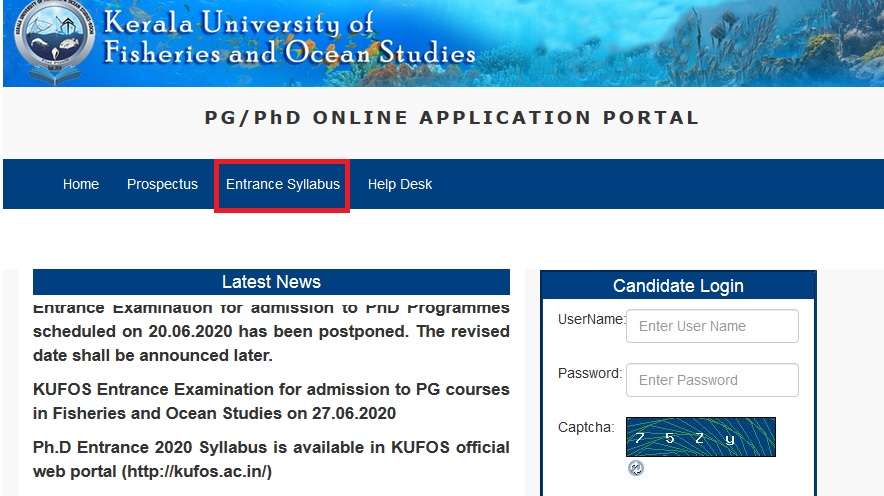KUFOS Ph.D Entrance 2020 Syllabus : Kerala University of Fisheries & Ocean Studies
Organisation : KUFOS Kerala University of Fisheries and Ocean Studies
Exam Name : KUFOS Ph.D Entrance Examination
Announcement : Ph.D Entrance 2020 Syllabus
Website : http://admission.kufos.ac.in/
KUFOS Ph.D Entrance Syllabus
Ph.D Entrance 2020 Syllabus is available in KUFOS official web portal.

Entrance Syllabus
Mathematics
Sets and their representation; Union, intersection and complement of sets and their algebraic properties; Power set; Relation, Types of relations, equivalence relations, functions;. One-one, into and onto functions, composition of functions.
Matrices, algebra of matrices, types of matrices, determinants and matrices of order two and three. Properties of determinants, evaluation of determinants, area of triangles using determinants.
Adjoint and evaluation of inverse of a square matrix using determinants and elementary transformations, Test of consistency and solution of simultaneous linear equations in two or three variables using determinants and matrices.
Fundamental principle of counting, permutation as an arrangement and combination as selection, Meaning of P (n,r) and C (n,r), simple applications.
Binomial theorem for a positive integral index, general term and middle term,properties of Binomial coefficients and simple application Arithmetic and Geometric progressions, insertion of arithmetic, geometric means between two given numbers.
Integral as an anti derivative. Fundamental integrals involving algebraic, trigonometric, exponential and logarithmic functions. Integration by substitution, by parts and by partial fractions. Integration using trigonometric identities. Integral as limit of a sum. Fundamental Theorem of Calculus. Properties of definite integrals.
Physics
Physics, technology and society, S I units, Fundamental and derived units. Least count, accuracy and precision of measuring instruments, Errors in measurement, Dimensions of Physical quantities, dimensional analysis and its applications.
Force and Inertia, Newton’s First Law of motion; Momentum, Newton’s Second Law of motion; Impulse; Newton’s Third Law of motion. Law of conservation of linear momentum and its applications, Equilibrium of concurrent forces. Static and Kinetic friction, laws of friction, rolling friction. Dynamics of uniform circular motion: Centripetal force and its applications.
Work done by a constant force and a variable force; kinetic and potential energies, work energy theorem, power. Potential energy of a spring, conservation of mechanical energy, conservative and nonconservative forces; Elastic and inelastic collisions in one and two dimensions.
The universal law of gravitation. Acceleration due to gravity and its variation with altitude and depth. Kepler’s laws of planetary motion. Gravitational potential energy; gravitational potential. Escape velocity. Orbital velocity of a satellite. Geo-stationary satellites.
Elastic behaviour, Stress-strain relationship, Hooke’s Law, Young’s modulus, bulk modulus, modulus of rigidity. Pressure due to a fluid column; Pascal’s law and its applications. Viscosity, Stokes’ law, terminal velocity, streamline and turbulent flow, Reynolds number. Bernoulli’s principle and its applications.
Surface energy and surface tension, angle of contact, application of surface tension – drops, bubbles and capillary rise. Heat, temperature, thermal expansion; specific heat capacity, calorimetry; change of state, latentheat. Heat transferconduction, convection and radiation, Newton’s law of cooling.
Thermal equilibrium, zeroth law of thermodynamics, concept of temperature. Heat, work and internal energy. First law of thermodynamics. Second law of thermodynamics: reversible and irreversible processes. Carnot engine and its efficiency Electromagnetic induction; Faraday’s law, induced emf and current; Lenz’s Law, Eddy currents. Self and mutual inductance.
Alternating currents, peak and rms value of alternating current/ voltage; reactance and impedance; LCR series circuit, resonance; Quality factor, power in AC circuits, wattless current. AC generator and transformer Electromagnetic waves and their characteristics.
Chemistry
Matter and its nature, Dalton’s atomic theory; Concept of atom, molecule, element and compound; Physical quantities and their measurements in Chemistry, precision and accuracy, significant figures, S.I. Units, dimensional analysis; Laws of chemical combination; Atomic and molecular masses, mole concept, molar mass, percentage composition, empirical and molecular formulae; Chemical equations and stoichiometry. Classification of matter into solid, liquid and gaseous states.
Measurable properties of gases; Gas laws – Boyle’s law, Charle’s law, Graham’s law of diffusion, Avogadro’s law, Dalton’s law of partial pressure; Concept of Absolute scale of temperature; Ideal gas equation; Kinetic theory of gases (only postulates); Concept of average, root mean square and most probable velocities; Real gases, deviation from Ideal behaviour, compressibility factor and van der Waals equation.
Thomson and Rutherford atomic models and their limitations; Nature of electromagnetic radiation, photoelectric effect; Spectrum of hydrogen atom, Bohr model of hydrogen atom – its postulates, derivation of the relations for energy of the electron and radii of the different orbits, limitations of Bohr’s model; Dual nature of matter, de-Broglie’s relationship

Download Syllabus
Entrance Syllabus : http://www.syllabus.gen.in/uploads/pdf2020/1728-syllabus.pdf